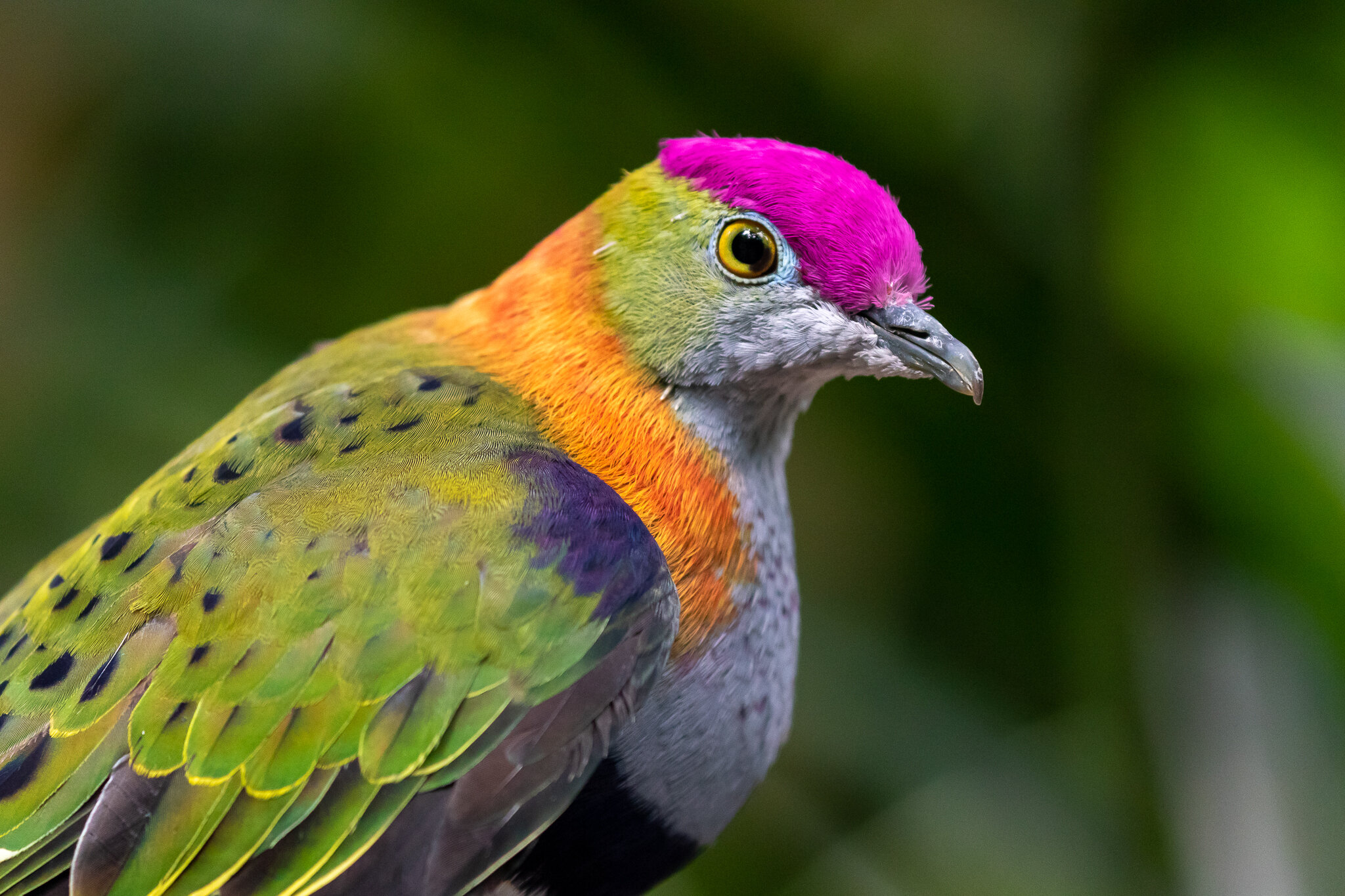Australian Pigeons
Australasia is the global centre of pigeon diversity and Australia has 29 species of the pigeon family, the Columbidae. Of these four are introduced, including the ubiquitous Rock Pigeon. Pigeons are stout-bodied birds with short necks. They have short slender bills suited to their diet of seeds and fruit. Their flight is rapid with clipped wing beats.
Photo: The Rose-crowned Fruit-Dove (24 cm) inhabits the rainforests and mangroves of northern and north-east Australia. The fruit diet of all the Fruit-Doves plays an important role in seed dispersal and the maintenance of diversity in tropical forests.
The Superb Fruit-Dove (24 cm) can be seen along Australia’s east coast but is now endangered in the south. It is found high in the rainforest canopy feeding on fruit and seeds.
Much larger is the Wompoo Fruit-Dove (48 cm), also inhabiting the east coast, feeding on rainforest fruit and seeds. This Wompoo was in the Rainforest aviary at Taronga Zoo in Sydney.
The White-headed Pigeon (40 cm) is found at forest fringes east of Australia’s Great Dividing Range. They feed on rainforest fruit and seeds and have a special taste for the introduced Camphor Laurel.
This Brown Cuckoo-Dove (45 cm) is also a bird of the forest’s edge, found along Australia’s east coast and as far north as the Philippines. They feed on fruit, berries and seeds.
The Emerald Dove (27 cm) is widespread across Southeast Asia and is found in the forests of northern and eastern Australia. They eat seeds and fruit, feeding on the ground.
Common Bronzewings (36 cm) are found across the Australian continent in a wide range of habitats. They feed on plants and seeds on the ground.
Another widespread bird is the Crested Pigeon (35 cm) seen in woodlands, on farms and often in the city. They are seed eaters feeding on the ground, sometimes taking insects when available.
This northern territory bird, the Partridge Pigeon (28 cm) was seen at Jabiru in Kakadu National Park. They eat grass and acacia seeds.
The Peaceful Dove (24 cm) inhabits the open woodlands across the eastern half and and northern parts of Australia. They feed from the ground on seeds and insects.
The Diamond Dove (24 cm) is named for the white spots on the wings of adult birds. They are found across most of Australia except Tasmania. They feed on the ground on grass seeds.
Bar-shouldered Doves (30 cm) live across the woodlands of eastern and northern Australia. They eat seeds of grasses, herbs and and fruit.
The Wonga Pigeon (40 cm) is a forest and woodland bird found on Australia’s south east fringe. They are great walkers feeding on seeds, fallen fruit and some insects.
The Topknot Pigeon (45 cm) is easily recognised by its bizarre headgear. They fly fast and far along Australia’s eastern parts in search of ripening fruit.
Pied Imperial Pigeons (42 cm) are distributed through Southeast Asia. They are found in Australia’s north, breeding during the spring and summer, many migrating to New Guinea for the winter. They feed in trees on fruit.
The Spotted Turtle-Dove (32 cm) is an introduced bird seen in eastern cities and country towns. They feed on the ground on grains, seeds and food scraps.
This Laughing Turtle-Dove (26 cm) was seen in Perth where it was introduced in the 1890’s. They feed on grain and seeds.
The Feral Pigeon or Rock Dove (35 cm), introduced from Europe, is seen widely across Australia, scavenging for food to supplement its diet of seeds.
The famous White Dove is in fact a white “Feral Pigeon” and is an introduced bird in Australia.


















